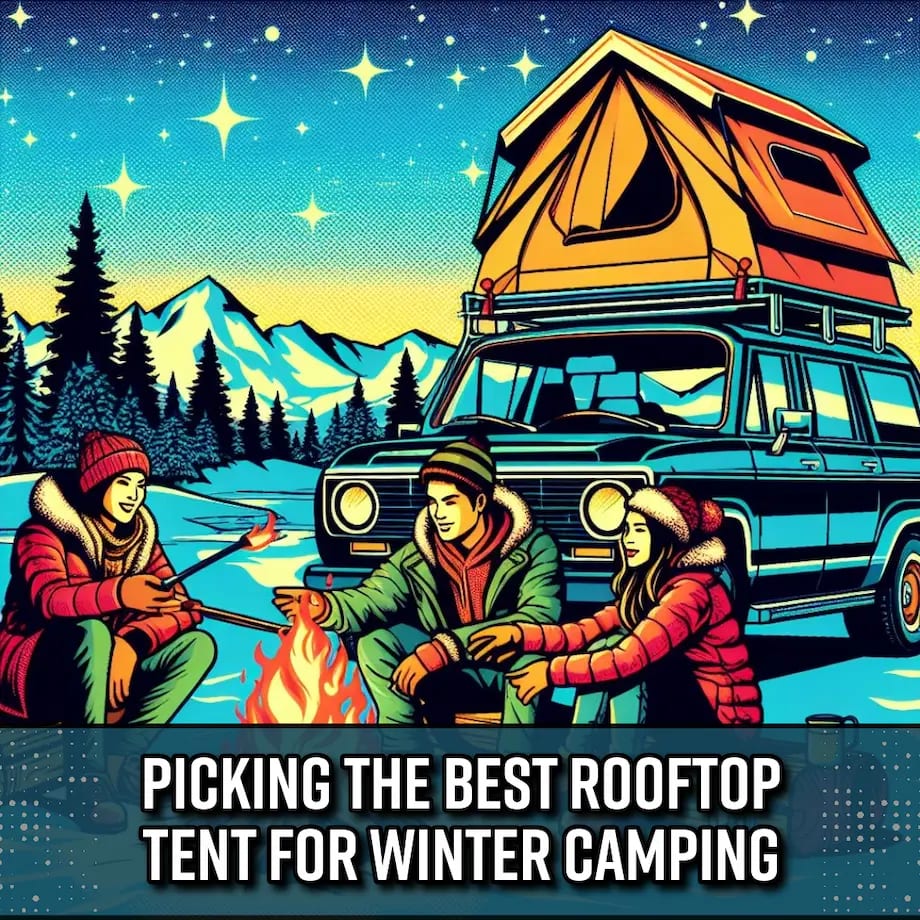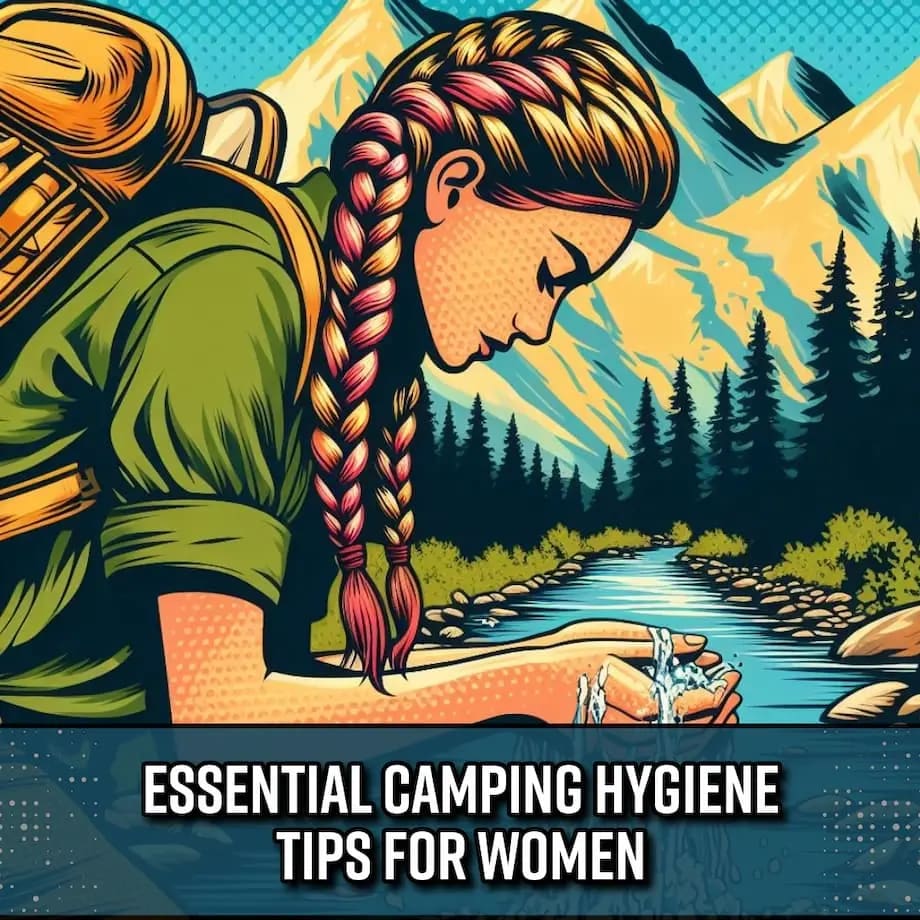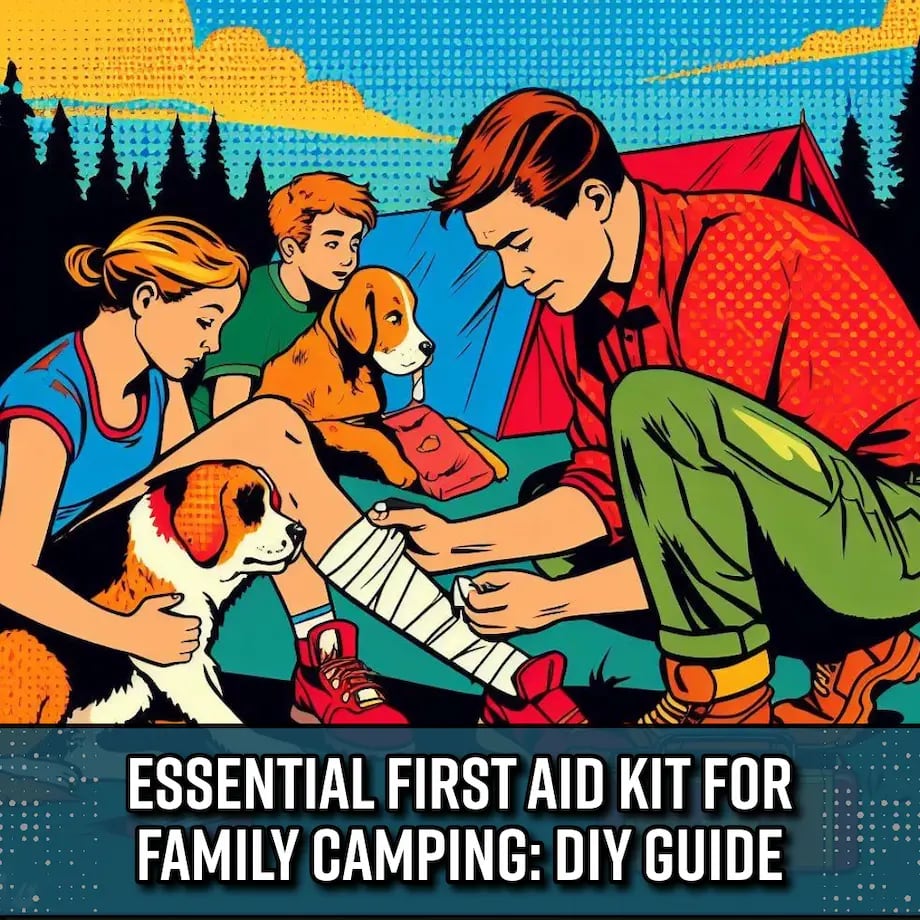Have you ever been in the calm and beautiful outdoors, but then worried about your family’s safety because you didn’t have a good first aid kit? Do you feel confident that you can handle a small emergency when you’re camping with your family, far from any hospital? Our guide on making your own First Aid Kit for Family Camping will give you everything you need to have. It’s not only about having the right tools; it’s also about feeling confident and making great memories safely with your family outdoors.
We have purchased many off the shelf kits, and have never been fully satisfied with them. In our experience it’s cheaper and better to build your own. In this guide we will help you put together a kit that is perfect for family camping. Of course this is just our opinion, based on years of camping experience, so feel free to make substitutions or additions to better fit your needs.

TLDR;
As we mentioned above, a DIY first aid kit is going to be a better value. Still, there is something to be said for convenience. If you are looking to pick up a high-quality kit without compromising on quality, consider purchasing a basic first aid kit like the one we suggest below. While it may be more expensive than a DIY kit, it offers all the basic supplies you’ll need and will serve you well.

Ever-Ready Industries Outdoor Adventure First Aid & Survival Kit with Tools & Outdoor Protection- Exceed OSHA Guidelines and ANSI 2009 Standards - 211 Pieces
Supply Checklist For Your Campers First Aid Kit
It’s important to include all these essential items in your kit. This way it will cover the common injuries and ailments that may occur while enjoying the great outdoors. There are other, more specialized, medical supplies that we have listed below that you may not need to bring. Many first responders believe that you shouldn’t have anything in your kit that you don’t understand how to use. Generally we agree which is why we have a separate list below for items that you may want to get training on before packing.
We have included a rough idea of the necessary quantity for each item on the checklist. Take that number with a grain of salt and adjust it based on factors such as the activities you’ll be engaging in, the length of your camping trip, and the size of your camping party. We have found that it’s best to have too much than not enough but you may want to include even more than we list below. This is especially true for gauze pads, waterproof bandages, and tweezers. Seriously we seem to lose a pair of tweezers every time we go camping, it’s almost suspicious lol.
When putting together your camping first aid kits we recommend making one for day hiking at the same time. Their contents are similar, but your hiking kit will be smaller and more specialized. We have a guide on putting together the perfect hiking first-aid kit that you might find helpful. By doing them at the same time you will save time and money by buying in bulk.
Essential Supplies (Download Printable Version)
Note: Never pack just one of anything. There’s a saying that “one is none” because in an emergency things will break or get lost. So always pack extras. Each item in the list links to Amazon for your convenience.
| Essential Supplies | Qty | Description |
|---|---|---|
| Non-latex medical gloves | 4-5 Pair | Safety and sanitation |
| Assorted adhesive bandages | 10+ Each | Different sizes for covering cuts and scrapes |
| Alcohol wipes | 50+ Packs | For disinfecting scrapes and cuts |
| Antibiotic ointment | 2 Tubes | For preventing infection |
| Anti-itch hydrocortisone cream | 2 Tubes | For mosquito bites and poison ivy |
| Irrigation syringe | 2 | For cleaning out cuts and wounds |
| Butterfly bandages | 10 | For wound closure |
| Gauze roll and/or pads | 25 Pads | For dressing larger wounds |
| Safety pins | 5-10 | Useful for securing bandages or as a tool |
| Quick clot gauze | 2 Packs | Stops severe bleeding quickly |
| Medical adhesive tape | 2 Rolls | For holding on gauze, splints, etc |
| Antiseptic wipes | 25 | To clean wounds and prevent infection |
| Pain and fever relief pills | 10 Pills | For discomfort and fever |
| Antihistamine pills | 10 Pills | For allergies and allergic reactions |
| Sunscreen | 2 Tubes | To protect against sunburn |
| Burn gel or cream | 2 Tubes | For treating minor burns |
| Instant cold and heat packs | 2 Each | For treating muscle strains and reducing swelling |
| Good metal tweezers | 2 Pair | For removing splinters or ticks |
| Good medical scissors or shears | 2 Pair | For cutting clothes or whatever needs cutting |
| Thermometer | 2 | Preferably digital |
| Moleskin Tape or blister pads | 2 Rolls | For treating blisters |
| Triangle bandage | 2 - 4 | For making splints and slings. |
| Insect repellent wipes | 2 Boxes | For dealing with sudden mosquito swarms |
| Flashlight or headlamp | 2 | With extra batteries |
| Whistle | 2 | For signaling in case of emergency |
| General first aid guide | 1 | For reference (See recommendation below) |

Tiny First Aid Guide: Emergency Medical Care for Anywhere - Step-by-Step, Pocket, EDC: Survival Medicine, Everyday Carry, Micro-Guide
Optional Supplies For Your Campers DIY First Aid Kit
In addition to the essential items mentioned in the previous section, these are additional supplies that you may consider including based on the time of year, your training, and expected activities.
| Optional Supplies | Qty | Description |
|---|---|---|
| Emergency blankets | 2 | Provides warmth and protection |
| CPR mask | 2 | PPE for doing CPR. |
| Oral rehydration salts | 1 box | For treating dehydration. |
| Glucose or energy gels | 2+ | For diabetic emergencies or low blood sugar situations. |
| Pulse oximeter | 1 | To measure oxygen saturation and pulse rate. |
| Israeli style trauma compression bandage | 2 | For traumatic wounds |
| Chest seal | 2 | For treating traumatic chest injuries |
| Blister treatment kit | 2 | More comprehensive than blister pads |
| Hypothermia thermometer | 1 | Capable of reading lower body temperatures |
| SAM Splint | 1 | A versatile, moldable splint for fractures and sprains. |
| Water purification tablets | 1 bottle | In case you need to purify drinking water |
| EpiPen (Epinephrine Auto-Injector) | 1-2 | For severe allergic reactions |
| Prescription Medications | 3 days | Extras in case of emergency |
Picking the Right Bag or Backpack
Selecting the right bag or container is almost as crucial as the items you put inside it. Through our adventures and a few misadventures, we have learned that the perfect first aid container isn’t just about looks; it’s about practicality and accessibility.
size and compartmentalization should be the first thing you consider. You want a bag that’s compact enough to carry, but with enough room to hold all your essentials. In our experience, a bag with multiple compartments or pockets is a must. It keeps everything organized, so you can quickly grab what you need in an emergency. There’s nothing more frustrating than rummaging through a jumbled mess of bandages and ointments when time is of the essence!
Durability is also important. We once had a first aid bag that ripped after just a few trips – not ideal when you’re miles away from civilization. Look for materials like heavy-duty nylon that can withstand rough handling and outdoor elements. A waterproof or water-resistant feature is a bonus, especially if you’re an all-weather camper like us. You don’t want your supplies getting soaked during a sudden downpour.
Accessibility is another huge factor. Choose a bag that opens widely and stays open on its own. Trust us, having a bag that flops closed while you’re trying to patch up a cut is maddening. Some bags come with loops or hooks to hang from a tree branch or tent pole, keeping everything in sight and reach.
Color might not seem like a big deal, but we prefer bright colors or bold patterns for our first aid kit. It makes it easy to spot, even if it’s buried at the bottom of a pack or if you’re searching in low light conditions. Also, a distinct color separates it from other gear, reducing confusion. Red is a pretty standard color that most people will recognize as a first aid kit immediately. Yellow and orange also work well.
First Aid Training and Resources
When it comes to being safe while camping, just having a first aid kit isn’t the whole story. Everyone in your camping group should know basic first aid and CPR. We learned this the important way: it’s not good enough to have just one person who knows what to do. That’s why we always tell people to get trained. Groups like the American Red Cross or American Heart Association offer great courses. And guess what? Even little kids, like 4 or 5 years old, can start learning the basics. So, it’s a great idea to get your kids learning early.
We are lucky because we both have held jobs that gave us first aid and CPR training. If you haven’t had that opportunity we strongly recommend seeking out the training on your own. These skills have been amazing, not just for camping and hiking, but in everyday life. We really believe everyone should have these skills. The training covers lots of stuff, like how to treat common injuries, do CPR, and help in medical emergencies.
Also, having a first aid manual is super helpful. It’s like a guidebook for emergencies. It shows you step-by-step what to do and is great if you need to quickly remember how to do something. You can pick a printed book or a digital one, but make sure it’s up-to-date and covers lots of different things you might need to know for camping.
Benefits Of Taking A First Aid Course
By investing in first aid training and resources, you are not only equipping yourself with life-saving skills but also contributing to the overall safety and well-being of your camping group. Remember, emergencies can happen anytime and anywhere, so it’s important to be prepared.
- Increased confidence. First aid training gives you the confidence to take immediate action in emergency situations, potentially saving lives.
- Effective response. With training, you will learn the proper techniques for administering first aid, ensuring your response is effective and potentially preventing further harm.
- Quick thinking. Training helps you develop critical thinking skills, allowing you to assess situations and make informed decisions in high-pressure scenarios.
- Life-saving skills. By learning CPR and other life-saving techniques, you can significantly increase the chances of survival for someone in need.
- Preparedness. Training prepares you to handle a wide range of emergencies, giving you the tools to respond effectively when every second counts.

Maintaining Your Campers DIY First Aid Kit
Proper maintenance of your first aid kit is crucial to ensure it’s ready for any camping adventure. Here are some tips to help you keep your kit organized, ready to use, and up-to-date.
- Keep it Stocked: Check your first aid kit before you head out to the campsite to see if any items have expired or need refilling. Discard any expired medications safely and replace them. We recommend keeping a supply list in your kit. This will help you when it comes time to restock, and it could help someone else quickly find what they need.
- Keep It Dry: Camping often involves exposure to moisture, so it’s important to keep your first aid kit in a waterproof container. This will protect the contents from getting wet and potentially becoming damaged or unusable. Consider using a durable plastic or metal container with a secure lid to keep your kit dry and in good condition.
- Keep it Accessible: In the event of an emergency, you want to be able to quickly and easily access your first aid kit. Keep it in a location that is easily reachable, such as in the trunk of your car or a designated compartment of your camping gear. This will ensure that everyone knows where it is and you can grab it quickly when needed.
Why Build Your Own First Aid Kit?
A lot of folks are curious about why we choose to make our own first aid kits instead of just buying them. Well, here’s the scoop: When you put together your own kit, you get to fill it with exactly what your family needs. For instance, thanks to the movie our granddaughters are now huge fans of Barbie, and you know what? We’ve got Barbie bandages in our kit! You’re not going to find those in a store-bought kit.
Think of creating your own first aid kit like sewing a custom outfit. It fits your family’s needs in a way that a purchased kit never will. You can pick and choose what goes into your kit based on your families needs and activities. And it’s not just about the stuff you put in there. You also get to decide how much of each item you need.
Here’s another important bonus: it saves money. Sure, grabbing a ready-made kit off the shelf is quick, but they can get pretty expensive. When you select items yourself, especially in bulk, the cost goes down. This way, you can splurge on some fancy items and save on others.
So, building your own first aid kit is more than just being prepared for the odd scrape or scratch. It’s about crafting something uniquely suited for your family. And there’s a real sense of pride in knowing you’ve put together something so important all by yourself!
The Advantages of Building Your Own First Aid Kit
- Customization: Tailor your kit to include specific camping safety items.
- Camping-Specific Supplies: Include bug bite treatment, blister care, and sunburn relief.
- Cost Savings: Purchase items individually to save money.
- Choose Quality: Opt for high-quality items known for their effectiveness.
The Importance of Being Prepared
Going camping with your family is such a great adventure, but here’s a super important tip: being prepared is key! Even if you’re new to camping, knowing how to handle the little surprises makes the trip safer and way more fun for everyone.
We’ve experienced the importance of having a well stocked first aid kit for family camping first hand. Think of it like your family’s camping guardian. Fill it with things for small cuts, bug bites, and other stuff that can happen. Knowing you have everything to handle these things gives you peace of mind.
But being ready isn’t just about the first aid kit and knowing basic first aid. Before you go, learn about where you’re camping. Are there animals to watch out for? Could the weather change quickly? Knowing this helps keep your family safe. A little bit of research can go a long way.
Don’t forget other safety tips too. Keep your food away from wild animals and make sure your campfire is completely out before you go to sleep. These small steps help prevent accidents.
We’ve learned from our own camping trips that surprises can pop up. But when you’re prepared, you’re ready for anything. This means you can relax, explore, and make amazing family memories in the great outdoors. Trust us, a little preparation makes a big difference!
Before You Go …
Now that you see how easy it is to set up your own campers DIY first aid kit I would like to suggest another article that should interest you. We have written a guide containing 7 simple campfire tips. If you follow those tips you hopefully won’t need to get out your first aid kit as often. Thanks for reading and have a safe camping experience.

FAQ
Q: Why is it important to have a first aid kit when camping?
A: Having a first aid kit when camping is essential because it allows you to quickly and effectively respond to minor injuries and potentially life-threatening situations. It helps you be prepared for any emergencies that may arise during your camping adventures.
Q: What are the advantages of building your own first aid kit?
A: By building your own first aid kit, you have the freedom to choose the specific items and quantities that meet your needs. You can customize your kit to include essential camping safety items and save money by purchasing items individually.
Q: What items should be included in a camping first aid kit?
A: A camping first aid kit should include adhesive bandages in multiple sizes, butterfly bandages for wound closure, gauze pads, medical tape, antiseptic wipes and cleaning liquid, pain and fever relief pills, instant cold and heat packs, tweezers, and a first aid guide for reference.
Q: Are there additional supplies that should be added to a camp first aid kit?
A: Yes, additional supplies that can be added to a camp first aid kit include quick clot gauze, moleskin, stainless steel tweezers, emergency blankets, non-latex disposable gloves, and over-the-counter medications such as antacids, antihistamines, and pain relievers.
Q: Is it necessary to create a separate hiking first aid kit?
A: Yes, it is important to create a separate hiking first aid kit that includes essential items such as bandages, blister treatments, antiseptic wipes, pain relievers, and an ace bandage for sprains or strains. The hiking first aid kit should be lightweight and compact for easy carrying during hikes.
Q: Are there any first aid training courses available?
A: Yes, organizations such as the American Red Cross and American Heart Association offer first aid training courses that teach you the necessary skills to respond to emergencies effectively. Taking a first aid training course is highly recommended.
Q: Are there pre-packaged first aid kits available for camping?
A: Yes, there are several options available for pre-packaged first aid kits specifically designed for camping and outdoor activities. Some recommended kits include the Ever-Ready Industries Outdoor Adventure First Aid & Survival Kit, MyFAK, Adventure Medical Kit Mountain Series Backpacker, and Uncharted Supply Co. First Aid Plus.
Q: How often should I check and restock my first aid kit?
A: It is important to regularly check and restock your first aid kit. Check the expiration dates of medications and replace any expired items. Consider keeping a list of the contents of your first aid kit to keep track of what needs to be restocked.
Q: Why is it crucial to be prepared for emergencies while camping?
A: Being prepared for emergencies while camping is crucial for your safety and the safety of those around you. By having a well-stocked first aid kit and the necessary skills, you can quickly and effectively respond to minor injuries and potentially life-threatening situations.
Q: Is a DIY first aid kit for campers a smart addition to camping gear?
A: Yes, a DIY first aid kit for campers is a smart and essential addition to your camping gear. By following the DIY first aid kit checklist and including the recommended items, you can be confident in your ability to handle minor injuries and emergencies while enjoying the great outdoors.
In Conclusion
Cuts, scrapes, insect bites, and blisters are a normal part of camping, especially when you have kids. Having the first aid supplies and training can keep these minor inconveniences from ruining the camping trip. Taking the time to put together a good kit and get some basic training will be more than worth the time. If you have anything to add please get in touch. Thanks for reading and have fun out there.
Related Blog Posts

Get ready to conquer winter camping like a pro! This article is your trusty sidekick in navigating the world of rooftop tents. Whether you're a seasoned winter warrior or a first-time frost explorer, this guide will help you pick the perfect rooftop tent for your needs, ensuring you'll be snug as a bug in your rooftop tent.

Embark on your next outdoor adventure with confidence using our essential guide to camping hygiene for women. From managing menstrual hygiene in the wilderness to maintaining overall cleanliness, this article provides practical, eco-friendly tips ensuring you stay fresh and comfortable, no matter where the trails take you. Dive in to make your camping experience worry-free and truly in harmony with nature.
By Summer and Bill

Summer and Bill are the dynamic duo behind Adventureite.com, a blog dedicated to inspiring others to explore the great outdoors. With a combined lifetime of experience traveling and adventuring across America, they have a wealth of knowledge to share. From hiking to camping, kayaking to travel, Summer and Bill are passionate about helping others discover the beauty of the natural world.
 Adventureite
Adventureite